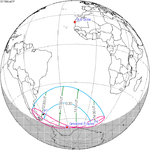Solar eclipse of June 28, 1908
| Solar eclipse of June 28, 1908 | |
|---|---|
| Type of eclipse | |
| Nature | Annular |
| Gamma | 0.1389 |
| Magnitude | 0.9655 |
| Maximum eclipse | |
| Duration | 240 s (4 min 0 s) |
| Coordinates | 31°24′N 67°12′W / 31.4°N 67.2°W |
| Max. width of band | 126 km (78 mi) |
| Times (UTC) | |
| Greatest eclipse | 16:29:51 |
| References | |
| Saros | 135 (33 of 71) |
| Catalog # (SE5000) | 9300 |
An annular solar eclipse occurred on June 28, 1908. A solar eclipse occurs when the Moon passes between Earth and the Sun, thereby totally or partly obscuring the image of the Sun for a viewer on Earth. An annular solar eclipse occurs when the Moon's apparent diameter is smaller than the Sun's, blocking most of the Sun's light and causing the Sun to look like an annulus (ring). An annular eclipse appears as a partial eclipse over a region of the Earth thousands of kilometres wide.
Places inside the annular eclipse included a part of North America including a part of Central Mexico around Mexico City and Orlando and Daytona Beach, Florida in the USA which occurred in the morning hours. In Africa, it included Rosso, Mauritania, the northernmost part of Senegal, Bamako and the southwestern French Sudan (now Mali), the southwesternmost part of Upper Volta (now Burkina Faso) and northern British Gold Coast (now Ghana) which occurred before sunset.
Related eclipses
Solar eclipses 1906–1909
This eclipse is a member of a semester series. An eclipse in a semester series of solar eclipses repeats approximately every 177 days and 4 hours (a semester) at alternating nodes of the Moon's orbit.[1]
The partial solar eclipses on February 23, 1906 and August 20, 1906 occur in the previous lunar year eclipse set.
| Solar eclipse series sets from 1906 to 1909 | ||||||
|---|---|---|---|---|---|---|
| Ascending node | Descending node | |||||
| Saros | Map | Gamma | Saros | Map | Gamma | |
| 115 | July 21, 1906 Partial |
−1.3637 | 120 | January 14, 1907 Total |
0.8628 | |
| 125 | July 10, 1907 Annular |
−0.6313 | 130 | January 3, 1908 Total |
0.1934 | |
| 135 | June 28, 1908 Annular |
0.1389 | 140 | December 23, 1908 Hybrid |
−0.4985 | |
| 145 | June 17, 1909 Hybrid |
0.8957 | 150 | December 12, 1909 Partial |
−1.2456 | |
Saros 135
It is a part of Saros cycle 135, repeating every 18 years, 11 days, containing 71 events. The series started with partial solar eclipse on July 5, 1331. It contains annular eclipses from October 21, 1511 through February 24, 2305, hybrid eclipses on March 8, 2323 and March 18, 2341 and total eclipses from March 29, 2359 through May 22, 2449. The series ends at member 71 as a partial eclipse on August 17, 2593. The longest duration of totality will be 2 minutes, 27 seconds on May 12, 2431.
| Series members 27–43 occur between 1800 and 2100: | ||
|---|---|---|
| 27 | 28 | 29 |
 Apr 24, 1800 |
 May 5, 1818 |
 May 15, 1836 |
| 30 | 31 | 32 |
 May 26, 1854 |
 Jun 6, 1872 |
 Jun 17, 1890 |
| 33 | 34 | 35 |
 Jun 28, 1908 |
 Jul 9, 1926 |
 Jul 20, 1944 |
| 36 | 37 | 38 |
 Jul 31, 1962 |
 Aug 10, 1980 |
 Aug 22, 1998 |
| 39 | 40 | 41 |
 Sep 1, 2016 |
 Sep 12, 2034 |
 Sep 22, 2052 |
| 42 | 43 | |
 Oct 4, 2070 |
 Oct 14, 2088 | |
Notes
- ^ van Gent, R.H. "Solar- and Lunar-Eclipse Predictions from Antiquity to the Present". A Catalogue of Eclipse Cycles. Utrecht University. Retrieved 6 October 2018.
References
- Earth visibility chart and eclipse statistics Eclipse Predictions by Fred Espenak, NASA/GSFC




